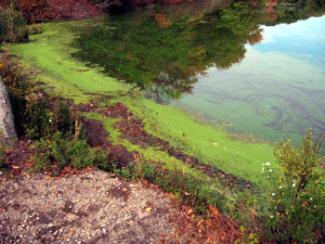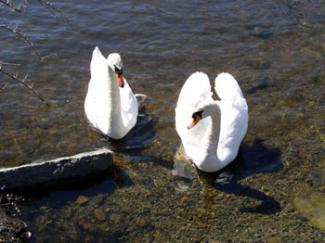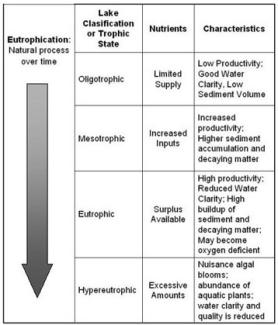Nutrients in Lakes

Nutrients, such as Phosphorus (P) and Nitrogen (N), are essential to plants and animals for healthy growth. The amount of nutrients in freshwater is influenced by the bedrock, type of vegetation, and differing land uses of the surrounding watershed. When a lake receives high amounts of nutrients (especially Phosphorus) from the surrounding watershed, the growth, or production of algae and plants may increase.
Nutrients accumulate in lakes from many sources:
- Air (called atmospheric deposition)
- Precipitation (rain or snow)
- Erosion
- Surface water run-off
- Storm water
- Decaying materials in the lake (dead plants or fish, leaf litter)
- Leachate from septic systems
- Use of lawn and agricultural fertilizers
- Animal waste

The process of nutrient accumulation and enrichment of lakes is called eutrophication. This "aging" process is a natural process in the life of all freshwater lakes: all lakes, even the most pristine, will accumulate nutrients and sediments over long scale timeframes. However, natural eutrophication is accelerated by human activities in the watershed. High inputs of nutrients can fuel heavy algal blooms and excessive plant growth. When this plant material dies and decays, lakes and ponds can be depleted of oxygen, harming aquatic life. Decay also results in nutrients accumulating in sediments. Nutrients in lake sediments are then released back into the water column in a continual nutrient cycling process. It is possible to reduce non-point sources of nutrients using best management practices and pollution prevention strategies.
Trophic Status of Lakes and Ponds
Lakes may be classified according to the degree of eutrophication using data on nutrient concentrations (P) or algal growth (often measured as Chlorophyll A). This lake classification, also known as trophic status, describes how "productive" a lake is, or how well it supports the growth of plants and algae. All lakes are expected to change their trophic status over time. Of the 103 lakes and ponds classified in RI, about one-third are eutrophic or hypereutrophic.

